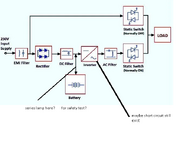Gaber Mohamed Boraey
Full Member level 2
Hello everyone
We repair UPS devices, the single phase and three phase , my question regarding the single phase types starting from 700watt capacity to 10kw ups
After replace damaged components, we not sure that everything ok , and we need make safe test, in other words , after replace damaged components there is reliability of “ boom “ for components, it happened many times with us
Now I need your help how to isolate the short circuit in the ups “ which is somewhere we not sure yet where “ , in other words when test on battery mode path, how to make safety test , 200 watt lamp as current limiter in series with the ups before battery supply is a solution?, or you have better idea?, if so how about when we have 16 battery or 20 battery ups?, which is up to 30*12v = 360v ?
So if the short circuit still exist the lamp will light?, and save the ups circuits?
attached photo for clarifacation
I hope that clear
Thanks
We repair UPS devices, the single phase and three phase , my question regarding the single phase types starting from 700watt capacity to 10kw ups
After replace damaged components, we not sure that everything ok , and we need make safe test, in other words , after replace damaged components there is reliability of “ boom “ for components, it happened many times with us
Now I need your help how to isolate the short circuit in the ups “ which is somewhere we not sure yet where “ , in other words when test on battery mode path, how to make safety test , 200 watt lamp as current limiter in series with the ups before battery supply is a solution?, or you have better idea?, if so how about when we have 16 battery or 20 battery ups?, which is up to 30*12v = 360v ?
So if the short circuit still exist the lamp will light?, and save the ups circuits?
attached photo for clarifacation
I hope that clear
Thanks
Attachments
Last edited:
